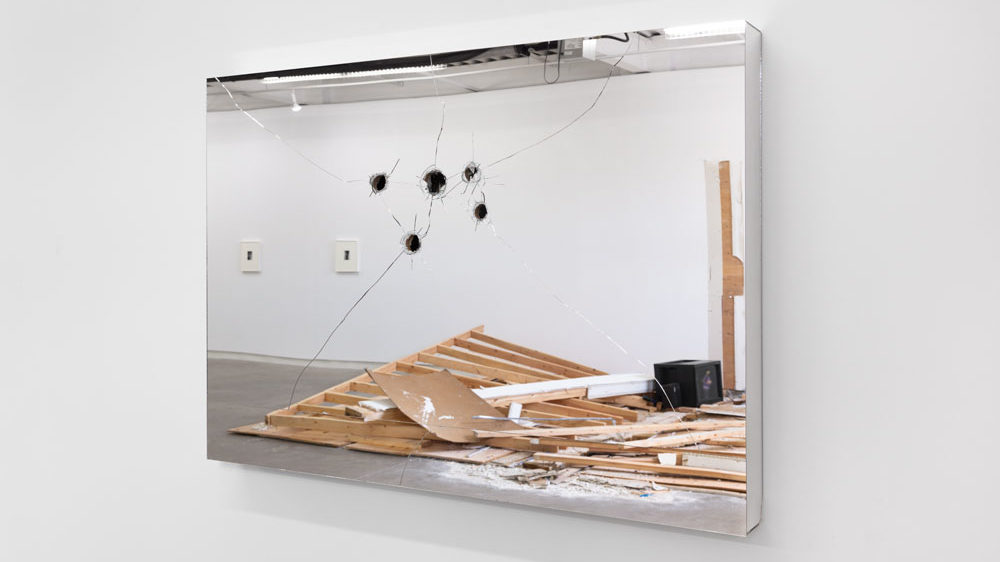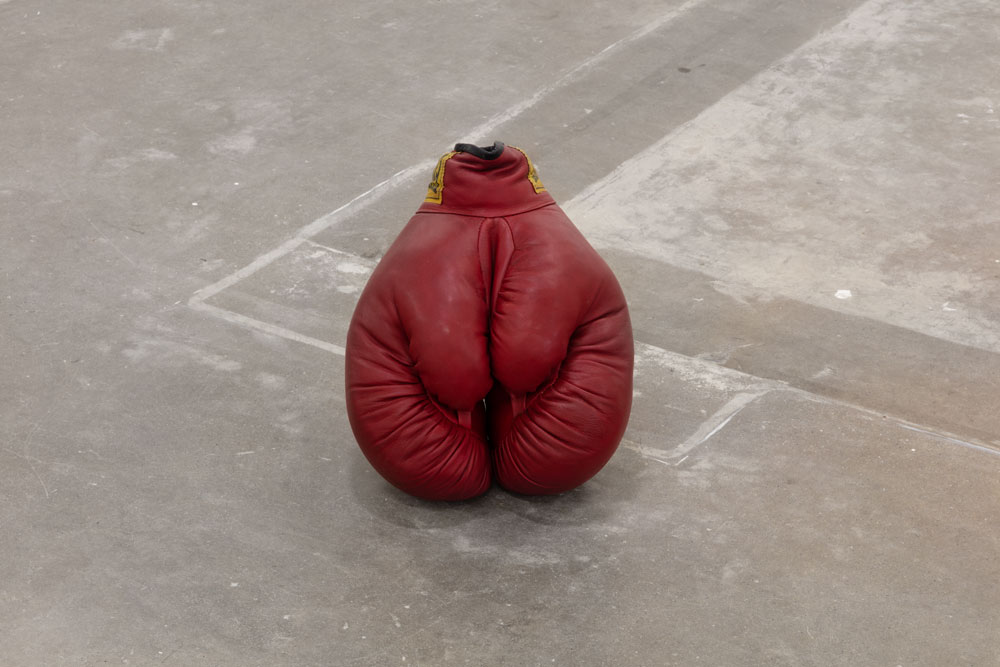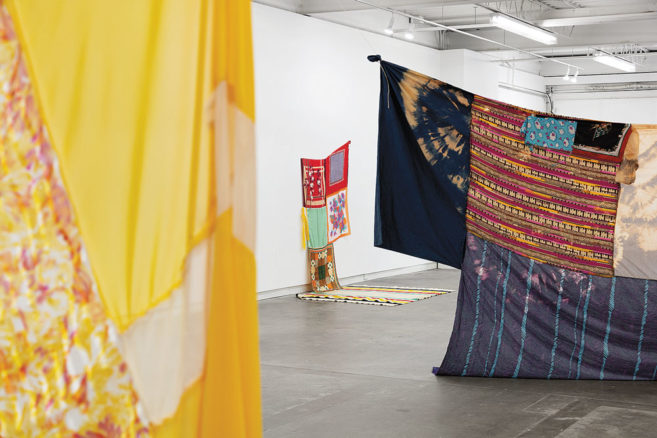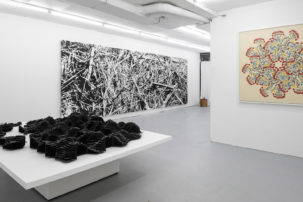Hanging above Scrap Metal’s entrance, Divya Mehra’s 2014 flag piece, There are Greater Tragedies, greets visitors with less welcome than warning: “MY ARRIVAL IS YOUR UNDOING” it reads, confronting one’s own arrival to the gallery in ways that feel vaguely threatening. The flag invokes the history of conquest and desire for domination that flag-raising symbolizes—think of the Battle of Iwo Jima or the aftermath of colonial arrivals. Without indicating who “my” or “your” are, it suggests only an uncertain relation between a “me” and “you” that may have one wondering which side they fall on, and why this relation is antagonistic. That uncertainty is what makes Mehra’s flag compelling: it underscores the inherent risk of simply existing in a world with others, where any meeting of persons is a potential conflict.
There are Greater Tragedies sets the tone for “Muscled Rose,” a group show, curated by Rui Mateus Amaral, that explores the uncertain dynamics of encounter. In addition to this flag, the exhibition includes sculptures by Julia Dault, David Altmejd and Michelle Bellemare; photographs by Chris Curreri; an On Kawara telegram; a video by Ragnar Kjartansson; and a Martha Graham video piece. These works are fairly different, but their canny grouping generates resonant connections; namely, they explore the multivalent affects of personal interactions. The strength of “Muscled Rose” is that it demonstrates how experiences of intimacy and violence can overlap and even be inextricable.
 David Altmejd, Untitled 3 (Puddles), 2013. Courtesy Scrap Metal, Toronto.
David Altmejd, Untitled 3 (Puddles), 2013. Courtesy Scrap Metal, Toronto.
In Altmejd’s Untitled 3 (Puddles) (2013), a mirror is pierced by what look like bullet holes, conjuring a violent attack. Up close, however, the punctures reveal another mirror behind the damaged surface. Here, as viewers glimpse themselves reflected inside the sculpture, marks of aggression open onto an intimate perspective. Nearby, Bellemare’s Everlast conjoins a pair of boxing gloves into a gesture of supplication—or prayer. The artist disarms an instrument of combat to expose something delicate. More explicitly, it’s hard not to see a vulva in the gloves’ mirrored folds. The gloves directly face Curreri’s close-up photos of bearded faces kissing (Kiss Portfolio, 2016), in which semi-abstract jumbles of tongues, lips and occasional fingers appear as similarly vulva-esque compositions. These transformations of loaded signs and symbols—of aggression, intimacy and eroticism (the bullet hole, the boxing glove, the kiss, the vagina)—upset our conventional ways of interpreting interpersonal relations. The intense kisses mimic a violent fight, even as they suggest tenderness, just as boxing’s macho posturing gives way to vulnerability when one exposes oneself, in public view, to another’s fist . It’s impossible to escape the sound of Kjartansson’s refrain, “Oh why must I keep hurting you” (Mercy, 2004), which comes from the gallery’s far corner and resonates throughout the space. A homage to Johnny Cash, this insistent line frames the experience of love in terms of our capacity to inflict and to receive pain.
Taken together, these works challenge the tendency to reduce conflict to Manichean tropes of aggressor and victim by calling forth a complex ambivalence that, like Mehra’s flag, undoes you. In that regard, “undoing” might not connote an act of violence or disenfranchisement but rather something more ethical. Perhaps it describes an encounter with an “other” that cannot be reduced to a “me” and “you” relation, an experience that confounds our identities but, in doing so, might allow us to renegotiate the terms of our coexistence.

Michelle Bellemare, Everlast. Courtesy the artist/Scrap Metal.

Chris Curreri, Kiss Portfolio, 2016. Courtesy the artist/Daniel Faria Gallery/Scrap Metal.

"Muscled Rose" Installation view, 2019. Courtesy Scrap Metal.

 Divya Mehra, There are Greater Tragedies, 2014. Courtesy the artist/Georgia Scherman Projects/Scrap Metal.
Divya Mehra, There are Greater Tragedies, 2014. Courtesy the artist/Georgia Scherman Projects/Scrap Metal.






